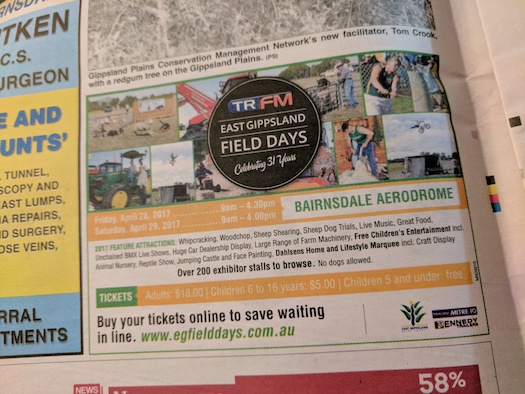Radio Tomorrow with James Cridland
Last week, during the holidays, I did a lot of driving. It turns out that Australia, my home country, is quite big: and a trip from Melbourne to Orbost, which looks tiny on the map, is actually four and a half hours.
I’d claim that I listened to a lot of radio while I was driving that distance; but my four year-old wouldn’t hear of it, and so I was “treated” to the entire available work of My Little Pony on Spotify, over and over again. I recommend “What my cutie mark is telling me” from Songs of Ponyville, incidentally: it isn’t annoying at all, and won’t have you gnawing the steering wheel in frustration as you hear it for the twentieth time.
I did, however, notice one radio station in particular – again and again.
While there are plenty of radio stations in Gippsland, the part of Victoria that I was driving in, you probably wouldn’t know that if you were driving there. You’ll probably only see one logo – that of TRFM.
One gas station had a banner for TRFM as I passed – a large banner with a frequency and a music positioner.
I saw many more TRFM logos at the bottom of road signs – those kind of road signs that tell you not to go to sleep, or not to try to send text messages, or to check your distance from the car in front, or not to speed. Signs that people will see every single day, on their drive to work or home, accompanied by their radio.
On opening the local newspaper, I saw an ad for the “TRFM East Gippsland Field Days”, an event which is sponsored by TRFM and is in its 31st year. The biggest local event for miles around, doubtless covered by the station, and carrying its name.
None of the ads were very large, and few of them told me any information. But I saw a lot of logos for TRFM during my driving: enough that it stuck with me, and enough that – were I asked what the local station was – I’d be able to answer without hesitation. It wasn’t the local ABC radio station, nor was it Hit Gippsland (owned by the biggest commercial radio group in Australia), nor TRFM’s sister station Gippsland’s 1242 – it was TRFM.
An old program director I worked for in the UK spent his marketing budget on similar things: he sponsored the shirts of one local football team and the stadium of another, he got the station logo on the back of the tickets for the local concert hall and theatre, and got involved with some local events, too. This meant that this station, The Pulse in Bradford rose from a lowly #8 in the market to a #1.
And, it’s no surprise that TRFM is also, easily, #1 in part of its market, too.
Even Google Maps likes TRFM, I later discovered – taking me a slightly scenic route via the TRFM building and some tall radio masts, complete with a rather quaint logo from eight years ago.
It isn’t sexy, but the very thing that works in radio advertising – frequency – made those little logos all over the road signs highly effective. It’s local, simple, and it worked for me.
About The Author
 James Cridland is a radio futurologist: a writer, speaker and consultant on the effect that new platforms and technology are having on the radio business across the world.
James Cridland is a radio futurologist: a writer, speaker and consultant on the effect that new platforms and technology are having on the radio business across the world.
He writes for publications across the world, and runs media.info the worldwide media information website. He also runs a free weekly newsletter with news of radio’s future.
British by birth, James lives in Brisbane, QLD and is a fan of craft beer.

